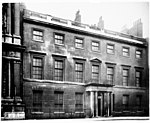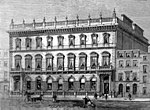Harding, Howell & Co.
1796 establishments in England1820 disestablishments in England18th-century fashionBritish companies disestablished in 1820British companies established in 1796 ... and 7 more
Buildings and structures in the City of WestminsterClothing companies of EnglandClothing retailers of EnglandDefunct department stores of the United KingdomDefunct retail companies of the United KingdomUnited Kingdom retail company stubsUse British English from September 2019

Harding Howell and Company's Grand Fashionable Magazine was an 18th-century department store at 89 Pall Mall in St James's, London. Open from 1796 to 1820, it could be considered a forerunner of the modern department store.The shop was divided into four departments, selling fur and fans, fabric for dresses, haberdashery, jewelry and clocks, perfume and millinery.
Excerpt from the Wikipedia article Harding, Howell & Co. (License: CC BY-SA 3.0, Authors, Images).Harding, Howell & Co.
St. James's Street, London Victoria
Geographical coordinates (GPS) Address Nearby Places Show on map
Geographical coordinates (GPS)
| Latitude | Longitude |
|---|---|
| N 51.50613 ° | E -0.13485 ° |
Address
Royal Automobile Club
St. James's Street 88 - 91
SW1Y 5HS London, Victoria
England, United Kingdom
Open on Google Maps









